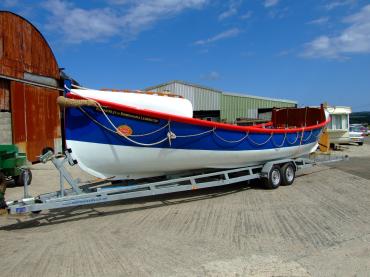Sponsors
National Historic Ships UK acknowledges the financial support of its sponsors
ROBERT and ELLEN ROBSON was a 34 foot Rubie designed Dungeness self righter. She was built by SE Saunders Ltd of Cowes in 1918 at a cost of £1615 10s 11d and was based at Tranmore from 1918 to 1923; Aberdeen from 1924 to 1939 and 1943 to 1947; and finally Whitby from 1947 to 1957. Whilst serving in Aberdeen, she saved a total of twenty one lives.
When the No2 lifeboat house and boat came out of service in 1957 application was made to the RNLI to turn the site into a museum. So ROBERT and ELLEN ROBSON went from being in service direct into a museum environment and hence remains very original. A later cosmetic restoration returned her finish to that of 1947 appearance when she went on service in Whitby.
She is understood to have been the last pulling lifeboat in RNLI service. Her last service took place on 24th Nov 1955 when the boat was launched to escort the fishing vessel PILOT ME into Whitby in poor weather. The use of Whitby’s No 2 boat arose because the No 1 boat RNLB MARY ANN HEPWORTH was in Scarborough having escorted other Whitby fishing vessels there the previous day.
Evidence for designs, functions, techniques, processes, styles, customs and habits or uses and associations in relation to events and people. How early, intact or rare these features are may impact on significance.
ROBERT and ELLEN ROBSON is a wooden 34 foot Rubie designed Dungeness self-righting lifeboat. Her hull is of double diagonal construction, with galvanised ironwork and copper fastenings. She is fitted with fore and aft castles and survivor seating along each side. Watertight compartments are installed fore and aft and she also has 6 relieving tubes amidships that drain through a single rectangular hull section. When she left service in 1957, her boathouse was converted into an RNLI museum and she was put on display on a period carriage. As a result, ROBERT AND ELLEN ROBSON has never undergone conversion or been out of RNLI ownership. Following many years on display, in 2021-22 she was restored back to her 1947 appearance. This involved removal and application of paint and finish, with all materials and colours kept in keeping to the 1950s livery. There were no changes to vessel fabric or structure, and she remains highly original.
Associations with people or places. Off-ship research.
ROBERT AND ELLEN ROBSON was built by SE Saunders Ltd of Cowes in 1918 and originally stationed at Tranmore in Ireland 1918 - 23, before transferring to Aberdeen (1924–39 & 1943–47) and then becoming Whitby’s No. 2 lifeboat giving her local significance to these areas. Whilst serving in Aberdeen, she saved a total of twenty-one lives. She was launched 15 times whilst at Whitby, gaining national importance when she escorted the fishing vessel PILOT ME into harbour in poor weather on 24 November 1955. This proved to be a historic event for the RNLI as it was the last time a rowing and pulling lifeboat was used on an operational service. ROBERT AND ELLEN ROBSON is displayed on one of the RNLI's only remaining pulling carriages which dates from circa 1880 and she was recorded on the National Register of Historic Vessels in 2009.
Overall aesthetic impact of the vessel, her lines, material she was built from and her setting. Does she remain in her working environment?
As a standard Rubie class lifeboat, ROBERT AND ELLEN ROBSON was strongly constructed with double diagonal planking and open-decked with end buoyancy boxes to make her as safe as possible at sea. She is presented in the RNLI fleet livery in which she would have been painted on her arrival at Whitby in 1947 and, sitting on her pulling carriage, is an aesthetically pleasing sight. She is on static display as the main exhibit in the Whitby RNLI Museum, appropriately sited in the town where she once served.
Source: NHS-UK team, March 2024
RNLI Museum Whitby
If you are the owner of this vessel and would like to provide more details or updated information, please contact info@nationalhistoricships.org.uk

National Historic Ships UK acknowledges the financial support of its sponsors